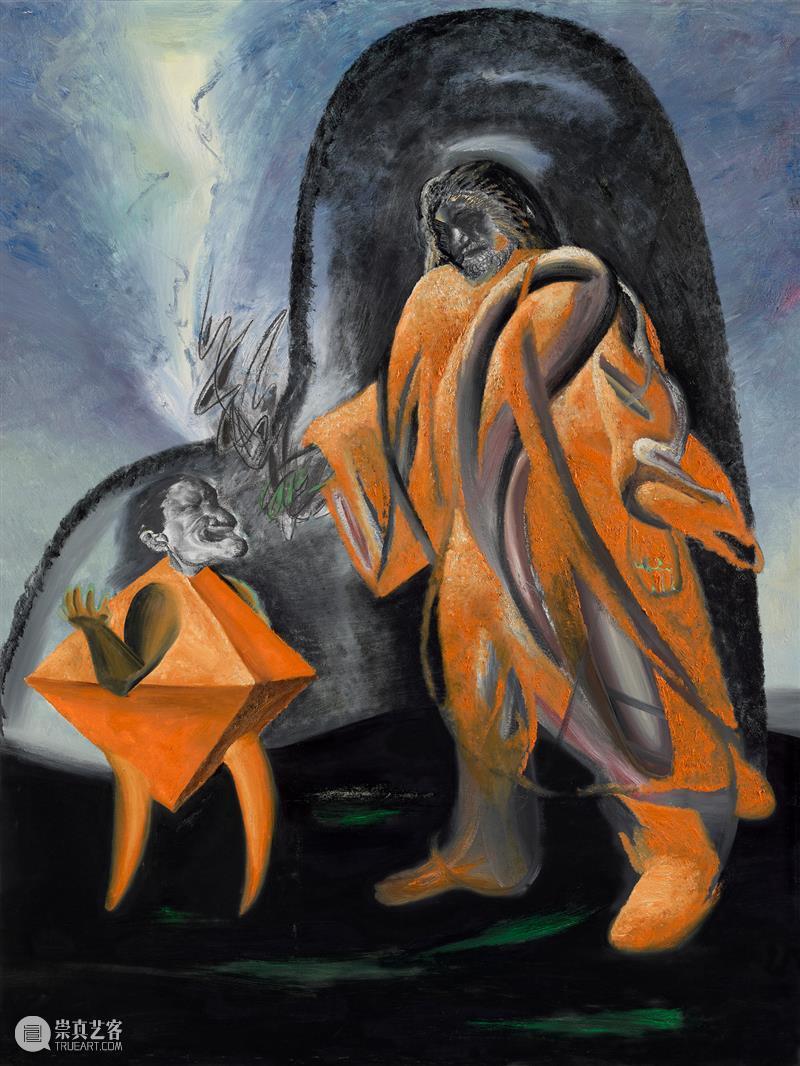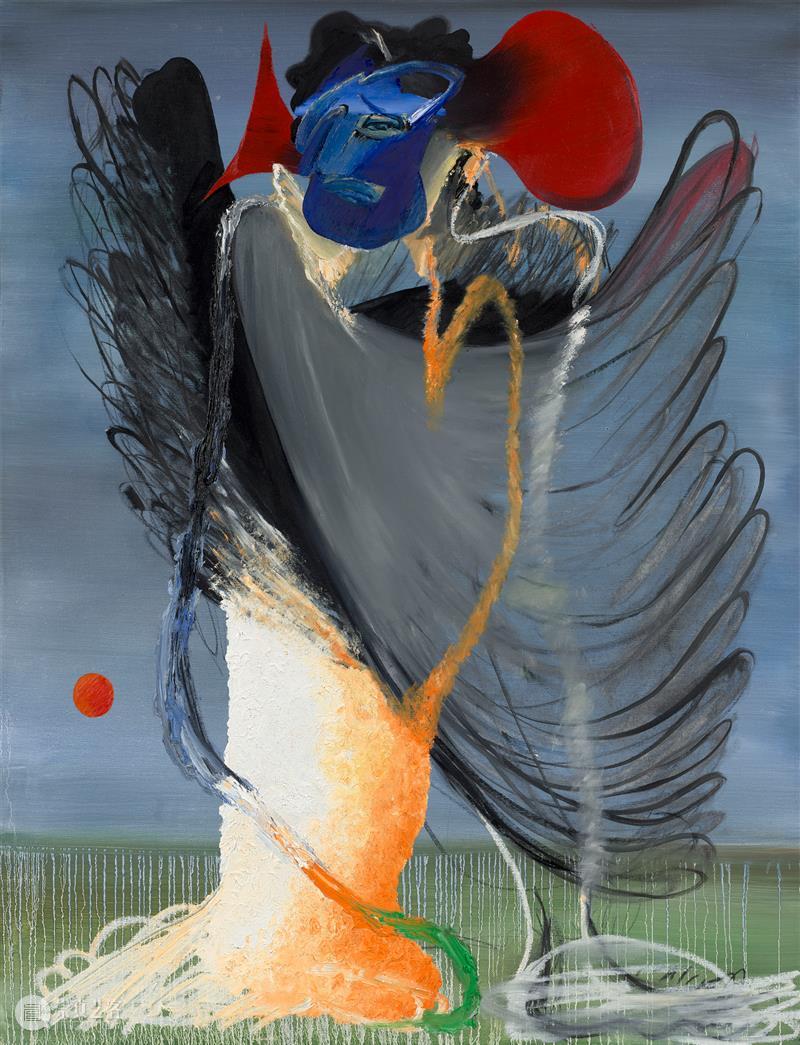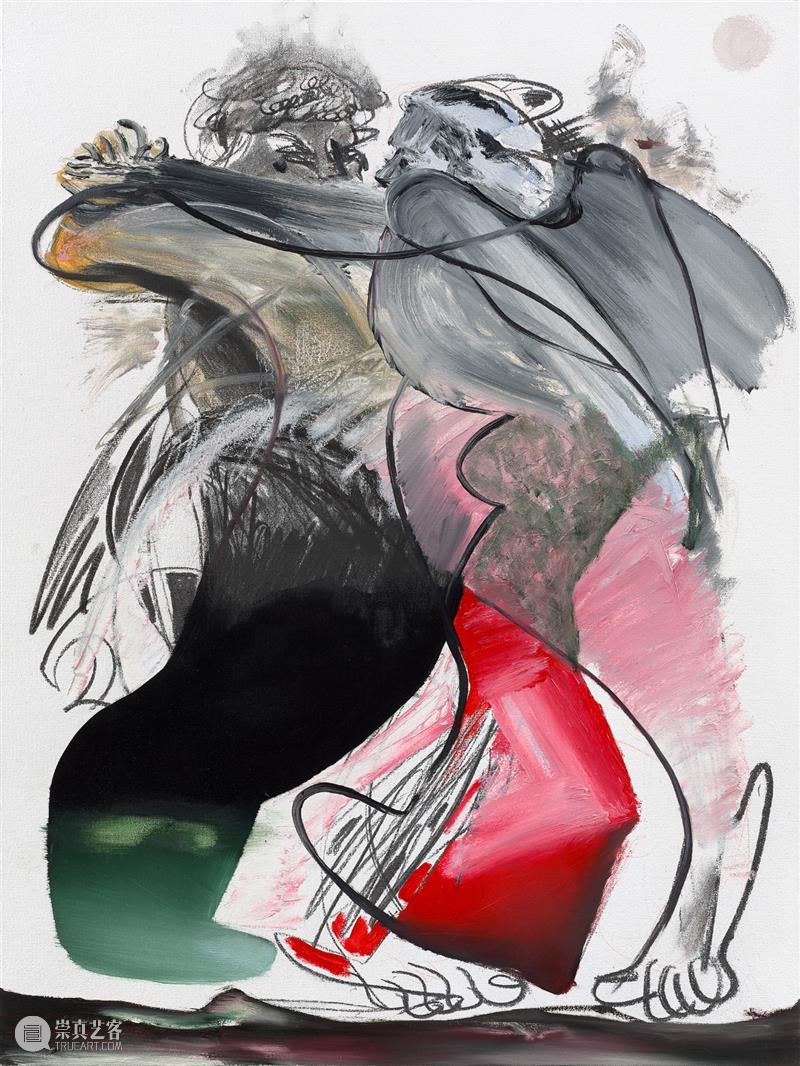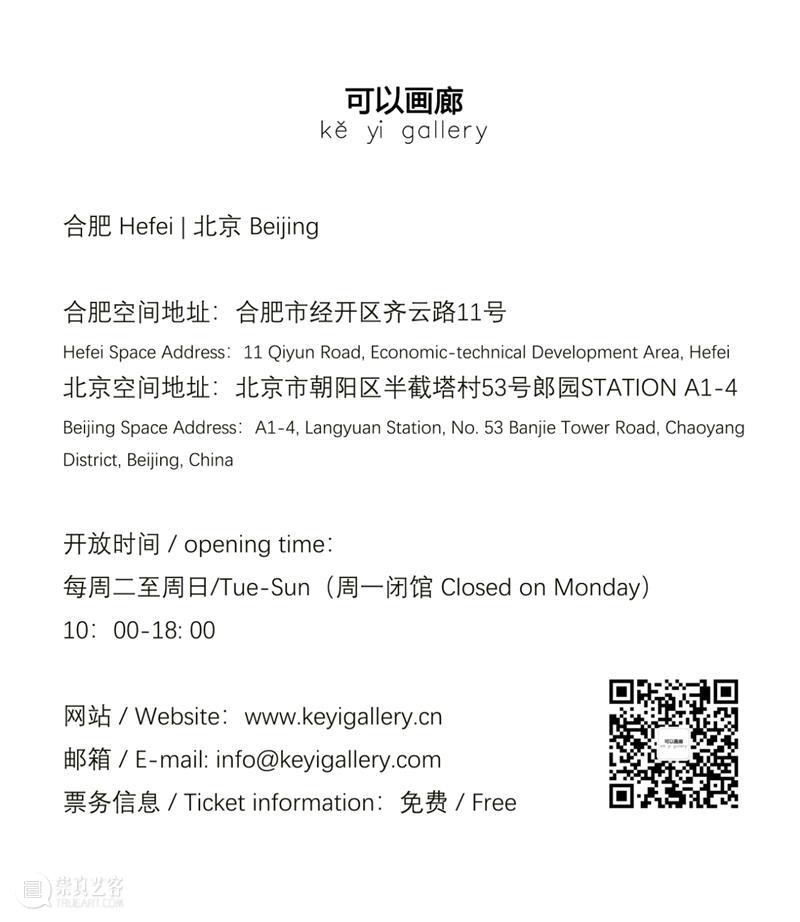访谈|李关帅的10个问题
![]() {{newsData.publisher_name}}
{{newsData.update_time}}
浏览:{{newsData.view_count}}
{{newsData.publisher_name}}
{{newsData.update_time}}
浏览:{{newsData.view_count}}
来源 | {{newsData.source}} 作者 | {{newsData.author}}
◆李关帅-L
◆可以画廊-K
K:欢迎关帅来到可以画廊合肥空间举办首次个展,简单介绍一下这次的展览主题——《赞歌》吧!
L:《赞歌》里这些画是我2022—2023年的作品,这些作品是我作为复杂个体对亘古未知与未来未知的想象与连接,它因我个人信仰与现实生活的差异,形成一种交缠的关系。末日般的虚假美景,沉默的、巨型的、意志被形象化的人物形象,都让我对生活、信仰、判断以及当下的一些文本、摄影与电影有新的拥抱。这些让我感觉是一首很长的赞美诗。也感谢可以画廊一起促成这个展览。
K:我们看到你的作品中常出现一些“神性”对象,这些形象的来源出自哪里?如何理解他们?
L: 这些形象大多源于一些电影、《神曲》或部分典故的文本、以及赛巴斯蒂奥等人的一些摄影作品中。我其实经常将这些视觉和文本元素理解得比别人看的还要复杂、无意义一些,所以我通常都不直接画,也绝对不是一种图像写生,也不是依据一段文本的情景再现,如果非要算是写生,它应该是在观看过后的对某种情绪和意志的写生。
K:对你来说“信仰”很重要吗?它和你的表达有什么关联吗?
L:重要,他影响我的判断超越了艺术影响我的判断,它使我在对自己认知的过程中发现自己身上多了一层复杂的成分,这个成分来源于信仰与现实的差异。
所以我觉得信仰这个词包含的信息太大了,叫我信…什么…好像更贴切一些。信仰在我绘画上的表达经常让我觉得绘画其实力不从心,因为人没办法想象出认知以外的东西。但想想,好像除了艺术能带来的这种超越文字的主观之外,再没有办法可以描述这些认知之外的东西了,“信仰”往往在认知之外,又在认知之内,文字没有办法传达这种信息。
L:无论我讨论什么,神秘也好浪漫也好,其实总会有更好的转换在画面上的办法,但是在这些办法之间来回徘徊后,再输出的画面结果可能会更有“绘画性”吧,因为它浓度有了。比如《卯日星君》里的形象,卯日星君作为一个我不信的虚构神,我不信但是为什么能引起我画它的欲望,就完全体现了我的复杂,很值得我去探问,这个过程总是在来回博弈,自然会体现在画面中卯日星君这个形象上,所以这个形象来回修改。有了这些前提达成的结果后,在我看来它就有了我想要的绘画性的浓度。宏观且抽象角度来讲它是一种结构限制下的反结构。K:了解到你之前在川美就读版画专业,你认为版画对你绘画最大的改变或影响是什么?
L:版画专业的学习对我帮助很大,版画它的限制更大,更具体,活动空间更少,版画的工序有简单有复杂,但其本身的属性都让当下的人很难有心思去把“画什么”这事考虑好,但版画的魅力在于他让我从另一种角度上学会了语言转换,后面再画油画时就可以挖掘画什么和怎么画这两件事的转换。让我学会如何在更少的限制里寻找自由度。
L:我现阶段把“精神性”理解为最重要的东西之一,其实这个东西和绘画性的浓度是紧紧挂钩的。比如一张画它的核心需要一个形象,但是有更“美观”的形象来代替它,这个美观现在是指视觉上看似有挑战的美,实际上对我没什么挑战。还落入一种我所塑造的普遍的美观中。然而为了表达核心你敢不敢突破这个普遍美观,就是我理解精神性的拉扯,也是绘画性的浓度。我们想象不出也做不出我们认知总和之外的东西,但作为艺术创作者,我认为我还是得做。
K:这次展出的作品中看到部分画面你做了留白处理,例如《观世》、《良夜2》,对此是如何考量的?
L:我觉得都是依据画面核心决定的,《观世》那张其实没有非常具体的文本,反而类似于多个文本的合集然后转换在画面上,但画面形象上很具体。这种文本的散发式的表达,场景暗示它最大的需求就是没有需求。《良夜2》源于雅各和天使摔跤,诡异的是它不是一场表面的对抗,是有极强的修辞在里面,对雅各来说这是美好的一夜,这个叙事它在场景上不能很具体,所以选择留白。
其实就算忽略这层内容的意义,正型和副型形成的仪式感或美感对我来说也很重要,留白其实会让这个东西变得明显。
有的作品有背景,是因为我觉得它文本需要延伸、想象过后直接转换在画面上。留白反而多少有一点传统的留想象空间的意思,它需要在画面上主动做延伸。
K:这次展出的十余件新作也大都为较大尺幅的作品,通常更习惯于大画创作吗?尺幅会直接影响你的表达吗?
L:是,因为我开始一张画时,文本来源或者视觉来源是需要加进一种复杂情绪,在画面中转换成形象。有时是浪漫,有时是神秘,但都具有仪式感,有这些原因存在,我的画需要尺寸。可以举个例子,之前我在寻找因着信仰社会驱使下的爱情故事的相关文本,我找到两篇反差不大的文本,因为两篇文字的氛围太不一样,在我看来就有尺幅大小之分。
比如《窄门》中阿丽莎和杰罗姆互相之间患得患失又夹杂着细微的温润的矫情,它的诉求就是夹带着这种氛围,所以大尺寸会失去这些表面暧昧的成分,除非我想主观扭曲、异化这段感情。然而保罗与弗朗西斯科的爱情带有很浓厚的悲剧色彩,他因着“畸形”的感情载体所以能带来很多新的判断,且在《神曲》中的修饰具有很强的仪式感。这样的氛围,在文本转换过程中对我来讲就需要尺寸。
L:画面语言我基本不编排,除了我觉得某局部对画面整体的影响很重要外,不然我更愿意常常靠着本能。
K: Welcome Guan Shuai to KeYi Gallery Hefei Space to hold his first solo exhibition. Please briefly introduce the theme of this exhibition - "Paean"!
L: These paintings in "Paean" are my works from 2022 to 2023. These works are my imagination and connection to the eternal unknown and the future unknown as a complex individual, which forms a tangled relationship due to the differences between my personal beliefs and real life. The false beauty of the apocalypse, the silence, the giant, and the visualised figure of the will gave me a new embrace of life, faith, judgment and some of the texts, photography and film of the moment. It feels like a long hymn to me. I would also like to thank KeYi Gallery for contributing to this exhibition.
K: We often see some "divine" objects in your works. Where do these images come from? How do we understand them?L: Most of these images come from some films, the <Divine Comedy> or some allusions to the text, as well as some photographs by Sebastiao and others. In fact, I often understand these visual and textual elements as more complex and meaningless than others see, so I usually do not draw directly, and it is not an image sketch, nor is it based on a text scene reproduction if it is a sketch, it should be a sketch of a certain emotion and will after watching.K: Is "faith" important to you? Does it have anything to do with your expression?
L: Important. It influences my judgment beyond the influence of art. It makes me find a layer of complex components in my body in the process of self-cognition, which comes from the difference between belief and reality.
So, I think the word “faith” is too big a message for me to believe... Whaaa... It seems more appropriate. The expression of faith in my paintings often makes me feel that painting is actually powerless because people can't imagine what is beyond cognition. But think about it. In addition to the subjectivity beyond words that art can bring, there is no way to describe what is outside of these cognitions; “belief” is often outside of cognition and within cognition, and words have no way to convey this information.
K: How do you see the painterliness in your work?
L: No matter what I discuss, mysterious or romantic, there will always be a better way to convert on the screen. Still, after wandering back and forth between these methods, the output of the screen result may be more "painting" because it has a concentration. For example, in the “Mao Li Xing Jun” image, Mao Li Xing Jun is a fictional god I do not believe. I do not think so, but why can it cause my desire to draw it? It fully reflects my complexity, and it is worth my questioning. This process is always in the game back and forth, naturally reflected in the image of Mao Li Xing Jun in the picture, so the image is revised back and forth. With the result achieved by these premises, it seems that it has the concentration of painting that I want. Macroscopically and abstractly, it is an antistructure under structural constraints.
K: I know that you studied printmaking in Sichuan Fine Arts Institute before, what do you think is the biggest change or influence of printmaking on your painting?L: The study of printmaking has helped me a lot. Printmaking is more restrictive, more specific and has less space for activities. Printmaking varies from simple to complex, but its properties make it difficult for people to think about "what to paint". Later, when painting oil paintings, you can find the conversion between what to paint and how to paint it. It taught me how to find freedom with fewer constraints.
K: How do you view the "spiritual pull" in creation?
L: At present, I understand "spirituality" as one of the most essential things closely linked to the concentration of painting. For example, a painting needs an image at its core, but a more “beautiful” image replaces it, and this beauty now refers to beauty that seems visually challenging but does not challenge me. And fell into a general aesthetic that I had created. However, to express the core, do you dare to break through this universal beauty? This is how I understand the pull of spirituality and the concentration of painting. We can't imagine or do anything beyond the sum of our perceptions, but as an artist, I think I must do it anyway.
K: In the works on display this time, you have left some pictures blank, such as "Observing the World" and "Good Night 2". How do you consider this?
L: It all depends on the core of the picture. The “Observing the World” picture does not have a particular text, but it is like a collection of multiple texts then transformed into a picture with detailed images. The diffuse expression of this text, the scene implies that its greatest need is the absence of need. "Good Night 2" comes from Jacob and the angel wrestling. The strange thing is that it is not a surface confrontation; there is strong rhetoric in it; this is a good night for Jacob; this narrative cannot be particular in the scene, so choose to leave it white.
In fact, even ignoring the significance of this level of content, the sense of ritual or beauty formed by positive and negative forms is also very important to me, and the white space actually makes this thing obvious.
Some works have a background because I think their text needs to be extended, imagined, and directly transformed in the picture. On the contrary, the white space has the traditional meaning of leaving imagination space, which needs to be actively extended on the screen.
K: More than ten new works in this exhibition are also primarily large-scale, usually more accustomed to creating large paintings. Does size directly affect your expression?
L: Yes, because when I start a painting, the text or visual source needs to add a complex emotion, and the picture is transformed into an image. Sometimes romantic, sometimes mystical, but both have a sense of ritual, and for these reasons, my paintings need size. For example, when I was looking for texts related to love stories driven by the faith society, I found two texts with little contrast because the atmosphere of the two texts is too different. In my opinion, there is a difference in size.
For example, in “Narrow Door”, Alyssa and Jerome suffer from each other's losses and mixed with subtle mild emotion, its appeal is to contain this atmosphere, so the large size will lose these surface ambiguous components unless I want to subjective distort and alienate this relationship.
However, the love between Paolo and Francesco has a tragic solid colour. Due to his "deformed" emotional carrier, he can bring a lot of new judgments, and the modification in the Divine Comedy has a strong sense of ritual—such an atmosphere in the text conversion process for me to need size.
K: How are you used to arranging the composition of the picture language?
L: I basically do not arrange the language of the picture, except that I think the influence of a certain part on the whole picture is very important. Otherwise, I would prefer to rely on instinct often.
K: Have there been any recent events that influenced your work a lot?
L: The studio moved and got bigger, but nothing else.
李关帅,1997年生于山东东营,2019年就毕业于四川美术学院版画系,2022年研究生毕业于四川美术学院造型艺术学院,曾在四川美术学院驻留,现工作生活于重庆。他的作品收藏于澳大利亚悉尼白兔美术馆,广东当代艺术基金会,罗中立美术馆等。他参与的群展包括:“驿驿其达”,龙美术馆,(重庆,2023);“在动物园散步才是正经事”,可以画廊(合肥,2023);“动态刷新”,罗中立美术馆(重庆,2023);“罗中立奖学金作品展”,芒果美术馆(长沙,2023);“向前的前一步”,赛麟空间(上海,2022);“折叠·覆盖”,鸿坤美术馆 (北京,2022);“固体与偏差”,重庆星汇当代美术馆 ( 重庆,2022);“信息捕捉器、超未来、启示、友爱共生”,北京妙有艺术(北京,2022);“无论盛开还是不盛开,花都是花” ,可以画廊(合肥,2022);" 礼物提名奖 " 作品展,并获得提名奖,罗中立美术馆(重庆,2022);明日视线奖,(杭州,2021);作品《我为什么在这里》,中国美术馆(北京,2018)等。Li Guanshuai born in 1997 in Dongying, Shandong Province, graduated from the Printmaking Department of the Sichuan Fine Arts Institute in 2019, and graduated from the School of Plastic Arts of the Sichuan Fine Arts Institute as a postgraduate student in 2022. He has been in residence at the Sichuan Fine Arts Institute, and now lives and works in Chongqing. His works are collected in the White Rabbit Art Museum, Sydney, Australia, Guangdong Contemporary Art Foundation, Luo Zhongli Art Museum, etc.The group exhibitions he participated:"Sprouting",Dragon Art Museum,(Chongqing,2023);“Walking in the Zoo is the most Serious Thing”, KeYi Gallery,( Hefei, 2023);“Dynamic refresh” ,Luo Zhongli Art Museum, (Chongqing, 2023);“Luo Zhongli Scholarship”, Mango Art Museum, (Changsha, 2022);“Look Before You Leap”, Sailing Space, (Shanghai, 2022);“Fold and cover”,HK Fine Art Museum,( Beijing, 2022);“Solids and Deviation”, Galaxy Museum of Contemporary Art, (Chongqing, 2022);“MOUart X Meta MOUart Group Exhibition 2022: Information catcher, super future, revelation, fraternal symbiosis”, MOUart, (Beijing, 2022);“Whether in Full Bloom or not, All Flowers are Flowers”, KeYi Gallery, (Hefei, 2022);“The 4th Gift Nomination Award” and won the nominated award, Luo Zhongli Art Museum,( Chongqing, 2022);“Hyper Youth Award”, (Hanghou,2021);The Work: “Why I am Here”, NAMOG, (Beijing, 2018),etc.
关于可以画廊 / About KeYi Gallery可以画廊 KeYi Gallery 是一间成立于2019年的当代新星空间,旨在为艺术家打造一个开放性的具有学术实验性的平台,致力推广多元独特的展览项目和艺术家作品,挖掘和培育年轻艺术家。可以画廊前身以私人收藏为主,20年间不断收藏那些具有一定学术价值的当代作品,并始终关注艺术当下及未来的发展趋势。
KeYi Gallery is a young contemporary art space established in 2019. It aims to create an open and experimental platform for artists and dedicates to promoting diverse unique art programs and works of art, exploring and developing young artists. KeYi Gallery gave priority to private collections previously and has been insisting on collecting contemporary artworks with high academic value while concentrating on art trends in the art world.
{{flexible[0].text}}

 {{newsData.good_count}}
{{newsData.good_count}}

 {{newsData.transfer_count}}
{{newsData.transfer_count}}














 分享
分享